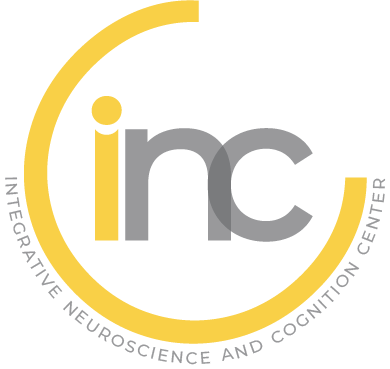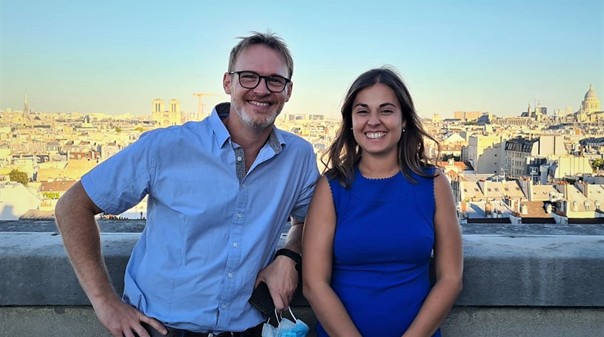A prestigious prize in medicine awarded to Filipa Barros (supervisor: M. Beraneck) for her PhD
Dr Filipa França de Barros was awarded a Prize in medicine from the Chancellerie des Universités de Paris for her PhD conducted entittled “Gaze stabilization in mice: visuo-vestibular adaptation and predictive motor signalling during locomotion”. The work was directed by Dr. Mathieu Beraneck, and conducted within the Spatial Orientation team of the Integrative Neuroscience and Cognition Center. Filipa França de Barros was a student at the doctoral school École Doctorale Cerveau Cognition Comportement.
Summary of the thesis
Visual information is crucial to animal species to act on, interact with and orientate in their environment. Gaze stabilization allows adequate visual acuity by ensuring that the visual scene is held stationary on the retina, even during movement. Sensorimotor systems are responsible for gaze stabilization through the use of complementary inputs that ultimately move the eye in space and/or the head in space.
This thesis first reports studies of two brainstem-converging sensorimotor pathways that enable gaze stabilization in mice. Specifically, it investigates how visual (OKR) and vestibular (VOR) reflexes adapt in response to a long-term visual perturbation. This was performed by means of a 2 weeks visuo-vestibular mismatch protocol in freely-behaving mice1. At a first instance, we demonstrated that the long term visuo-vestibular mismatch protocol lead to plasticity outside the cerebellum, namely in the direct VOR pathway2. Neural changes occurred in the synaptic transmission and intrinsic properties of central vestibular neurons. Next, the adaptation and recovery dynamics of the OKR and VOR reflexes were compared in two mismatches that differed in the amount of retinal slip3. Overall, these data provide evidence for sequential cascades of plasticity in the OKR/VOR pathways.
In addition to classical sensorimotor pathways, recent evidence demonstrated in Xenopus tadpoles the role of predictive motor signaling in helping minimize visual disturbances during locomotion. Efference copies are neural replicas of motor outputs used to anticipate the sensory consequences of a self-generated motor action or to coordinate neural networks involved in distinct motor behaviors. An established example of this motor-to-motor coupling is the efference copy of the propulsive motor command, that supplements classical visuo-vestibular reflexes to ensure gaze stabilization during amphibian larval locomotion. Such feedforward replica of spinal pattern-generating circuits, produces a spino-extraocular motor coupled activity that evokes eye movements, spatio-temporally coordinated to tail undulation independently of any sensory signal. Exploiting the developmental stages of the frog, studies in metamorphing Xenopus demonstrated the persistence of this spino-extraocular motor command in adults, and its developmental adaptation to tetrapodal locomotion. During this thesis, we demonstrate for the first time the existence of a comparable locomotor-to-ocular motor coupling in the mouse. In neonates, ex vivo nerve recordings of brainstem-spinal cord preparations reveal a spino-extraocular motor coupled activity similar to the one described in Xenopus. In adult mice, trans-synaptic rabies virus injections in lateral rectus eye muscle label cervical spinal cord neurons closely connected to abducens motor neurons. Finally, treadmill-elicited locomotion in decerebrated preparations evokes rhythmic eye movements in synchrony with the limb gait pattern. Overall, our data are evidence for the conservation of locomotor-induced eye movements in vertebrate lineages. Thus, in mammals as in amphibians, CPG-efference copy feedforward signals might interact with sensory feedback to ensure efficient gaze control during locomotion4.
Furthermore, this thesis features a collaboration with the group of Saaid Safieddine at Institut Pasteur where AAV-mediated gene therapy was used to durably restore the auditory and vestibular functions of a mouse model of Usher 1 syndrome. USH1-/- mice display profound deafness and locomotor dysfunction suggesting vestibular disorders5. In this study, our team measured the vestibulo-ocular reflexes from canal and otolith origin of treated or non-treated Knock-out USH1-/- mice using videoculography. While USH1-/- mice failed to evoke compensatory eye movements, injected USH1-/- mice exhibited responses that were close to those of wild-type. Hence, the AVV-mediated gene therapy was able to restore the vestibular function. This seminal study has since led to several ongoing collaborations with other groups at Pasteur institute all aiming at developing new therapeutic lines for patients suffering from inner ear pathologies.
Overall, this thesis provided insight to the functional complementarity of reflexive pathways participating in gaze stabilization as well as their adaptation to different behavioral and environmental contexts.
Keywords: gaze stabilization, VOR, OKR, vestibular, brainstem, sensorimotor, efferent copy, central pattern generators, motor-to-motor coupling.
Acknowledgments
This work, developed between October 2016 and March 2020, was funded by the French entities: Agence Nationale de la Recherche (ANR, ANR-15-CE32-0007) Centre national d’Études Spatiales (CNES), and the Centre National de la Recherche Scientifique (CNRS).

References
(1) França de Barros, F.; Carcaud, J.; Beraneck, M. Long-Term Sensory Conflict in Freely Behaving Mice. J. Vis. Exp. JoVE 2019, No. 144. https://doi.org/10.3791/59135.
(2) Carcaud, J.; França de Barros, F.; Idoux, E.; Eugène, D.; Reveret, L.; Moore, L. E.; Vidal, P.-P.; Beraneck, M. Long-Lasting Visuo-Vestibular Mismatch in Freely-Behaving Mice Reduces the Vestibulo-Ocular Reflex and Leads to Neural Changes in the Direct Vestibular Pathway. eNeuro 2017, 4 (1). https://doi.org/10.1523/ENEURO.0290-16.2017.
(3) França de Barros, F.; Schenberg, L.; Tagliabue, M.; Beraneck, M. Long Term Visuo-Vestibular Mismatch in Freely Behaving Mice Differentially Affects Gaze Stabilizing Reflexes. Sci. Rep. 2020, 10 (1), 20018. https://doi.org/10.1038/s41598-020-77026-w.
(4) França de Barros, F..; Bacqué-Cazenave, J.; Taillebuis, C.; Courtand, G.; Manuel, M.; Bras, H.; Tagliabue, M.; Combes, D.; Lambert, F. M.; Beraneck, M. Conservation of Locomotion-Induced Oculomotor Activity through Evolution in Higher Tetrapods; 2021; p 2021.06.26.450039. https://doi.org/10.1101/2021.06.26.450039. In press in Current Biology.
(5) Emptoz, A.; Michel, V.; Lelli, A.; Akil, O.; Boutet de Monvel, J.; Lahlou, G.; Meyer, A.; Dupont, T.; Nouaille, S.; Ey, E.; Franca de Barros, F.; Beraneck, M.; Dulon, D.; Hardelin, J.-P.; Lustig, L.; Avan, P.; Petit, C.; Safieddine, S. Local Gene Therapy Durably Restores Vestibular Function in a Mouse Model of Usher Syndrome Type 1G. Proc. Natl. Acad. Sci. U. S. A. 2017, 114 (36), 9695–9700. https://doi.org/10.1073/pnas.1708894114.

